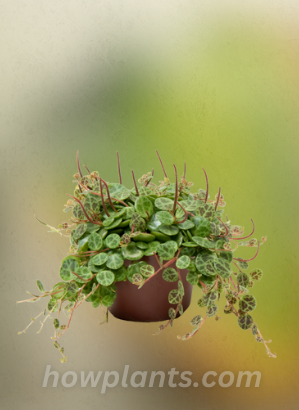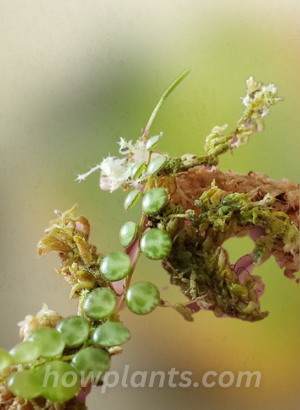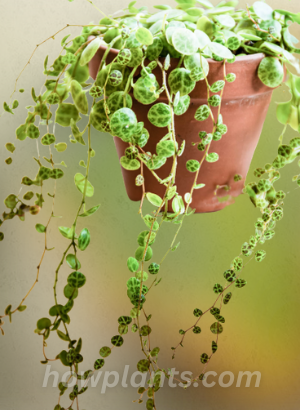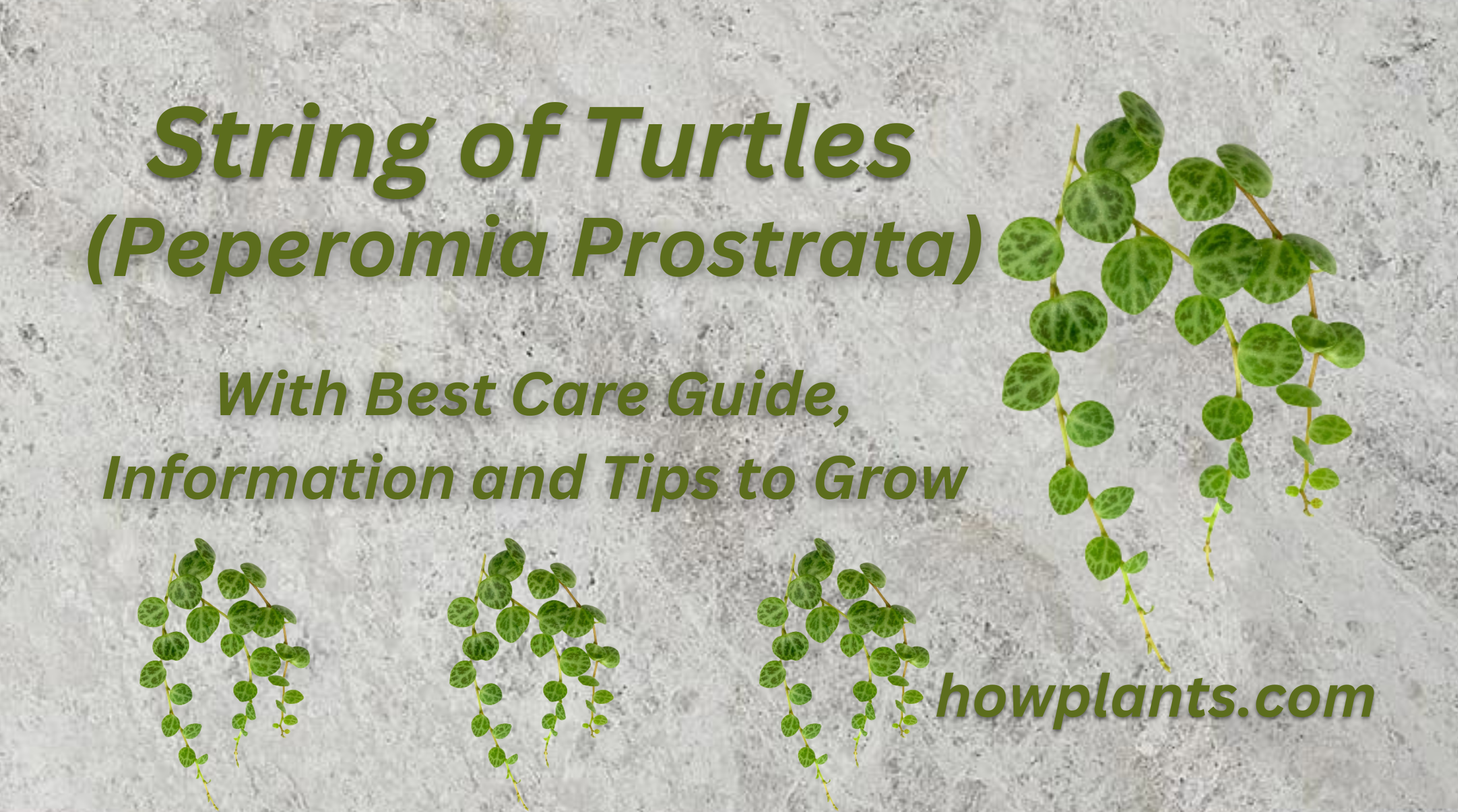String of turtles is a very popular houseplant due to its succulent like appearance or attractive turtle shell like leaves. If you are looking for tips and advice on caring for a string of turtles? Then in this comprehensive guide you will learn the basics about this plant, from watering and light requirements, to repotting and propagation. Methods to grow this plant and the solution to all the problems like yellow leaves, falling of leaves, pest attacks etc are all well explained in this guide.
Peperomia Prostrata, commonly known as the ‘string of turtles’ is an attractive and versatile houseplant. It has a succulent-like appearance, with long and slender stems that can reach up to 12 inches in length. The leaves are thick, waxy and spoon shaped, making it an eye-catching addition to any home. Its rarity, combined with its ability to thrive in lower light conditions. Caring for this type of Peperomia isn’t difficult, but there are certain tips and pieces of information you should be aware of in order to keep your plant healthy and happy. The leaves of this plant resemble a turtle’s shell. This plant can also grow indoors or in the wild.
What are String of Turtles?
This low-growing plant has thin stems and small, glossy leaves that make it an ideal choice. Native to the tropical regions of Central America, Strings of Turtle is a true showstopper with its heart-shaped foliage in shades of green and occasionally pinkish hues. Its trailing stems can grow up to 16 inches long when allowed to sprawl over the edges of containers or hanging planters. Best grown in bright indirect light.

Turtle Plants: Biological History, Importance and Origin
These plants have been commonly cultivated since the 1800s. The popularity of this plant has grown over time due to its interesting biological history and unique features. First identified by Swedish botanist Carl Linnaeus in 1753, it is believed that this species was brought to Europe from tropical areas where it had become naturalized in gardens and other cultivated areas.
Strings of turtles are Best for limited spaces. With proper care and attention, this low-maintenance plant can bring life to even the smallest of living spaces.
Difficulties you face in Caring of Turtle Leaf
String of turtle, also known as the Radiator Plant. However, taking care of this plant can come with some challenges. One of the most difficult tasks when caring for this plant is controlling its growth rate. Unlike other plants that grow quickly and need to be repotted regularly, this plant grows slowly and should only be repotted when absolutely necessary. This can make it difficult to manage the size of your string of turtle collection without over-watering or over-pruning. Another difficulty associated with taking care of this plant is providing adequate humidity levels in order to maintain a healthy environment for your plant.
Variegated Turtles String: Trailing Vines Appearance
With its bright green and red leaves, the plant is sure to be a conversation starter in any room. Commonly also known as rainbow peperomia. The long vines of this plant are perfect for hanging baskets or window boxes where their cascading effect can be appreciated. The airy leaves will provide interest in any look while providing an effortless way to add color into your decor.
Flowering Spikes: Appearance
Shape of Turtle String Flowers Looks like?
This plant has a stunning flower appearance with deep green oval shaped leaves that are characterized by their wavy edges. The blooms of this plant typically carry white petals and thick yellow centers, adding to the beauty of the foliage. These plants will usually bloom from late winter to early spring and can last several weeks if given proper care. In this guide we will discuss everything you need to know about caring for your string of turtles so it can display its beautiful flowers year round!

String of Turtles are Succulent Nature
This is a succulent plant species belonging to the Piperaceae family. The succulent nature of this plant makes it an ideal choice for any home balcony or terrace.
The succulent nature of this plant has some important benefits. Firstly, these plants are highly tolerant to drought due to their thick stems and fleshy leaves, which allows them to store water during dry periods. Secondly, this plant prefers warm temperatures and bright light.
Methods to Grow String of Turtle Plant
In this article, we will discuss the methods used to successfully grow/bloom the String of turtles in your home. First, you need to decide on what type of pot you will use. For smaller plants, it’s best to go with a shallow container that allows good drainage. The soil should also be well-draining and nutrient rich in order to ensure proper growth and health of the plant. Additionally, it’s important that the container has holes in the bottom so excess water can escape easily during watering sessions. Seeds of string turtles have a low rate of germination especially when they are older than 2 years old. Cuttings can be used to grow this plant.
Propagates through the piece of Roots and Stems
Its most notable feature is the fact that it can be easily propagated through the use of a piece of its root or stem which makes it an extremely popular choice.
The leaves of this plant are usually glossy green with dark purple streaks running along the veins. They can also tolerate low light conditions if needed. When watering, they should be watered only when the top soil becomes dry; overwatering can lead to root rot so it’s important to keep an eye on them!
Repotting of String of Turtles
To ensure your String of turtles remain healthy and vibrant, proper care should be taken when repotting.
Need of Repotting
Though repotting is an essential step,but what are the signs that tell you when it needs to be done? This article provides an informational guide on String of turtles care, including tips on when and how to repot this popular houseplant. Repotting should be done every 1-2 years depending on the growth of the plant and the size of its current pot. When selecting a new pot, make sure it is no more than one to two inches larger than the current pot. Additionally, use well-draining soil that is high in organic matter, such as peat moss or coco coir mixed with perlite and vermiculite for extra drainage.Some other indications that you need to repot include wilting leaves despite adequate watering or if there are pest infestations present in the soil.
Steps of Repotting
Here are some helpful steps to take when repotting your String of turtles:
First, you’ll want to gather the necessary materials: potting soil, a new pot or container that’s slightly bigger than the old one, scissors or pruning shears (if needed), and water.
Traits of Turtle Strings
The distinct feature of the turtle’s strings are its small greenish-brown leaves that grow in clusters along slender dark brown stems. These lush plants prefer bright but indirect light for optimal growth and can tolerate some shade as well.
Rate of growth
It has an average rate of growth that makes it perfect for novice growers.
This plant grows best in temperatures between 65-75 degrees Fahrenheit with medium levels of humidity and indirect sunlight. The soil should be kept slightly moist but not soggy at all times. Fertilizing once every two weeks during the growing season should suffice its needs for nutrients.
Average plant length
The average length of this plant can be quite variable but typically falls somewhere between 8-10 inches tall when fully grown.
Age of maturity
It’s important to understand its age of maturity in order to provide proper care.
This plant typically reaches full maturity at around 8 months old when grown indoors. During this period there are several key signs that indicate maturity, including thickening stems and longer leaf petioles (the part of the leaf stem that attaches it to the branch). At maturity, String of turtles may start flowering with tiny white blossoms as well as producing offsets (small baby plants growing off the side of mature ones).
Length at the age of maturity
The age at which this plant reaches its maturity is an important factor when considering how large the specimen will eventually grow.
The size at maturity of this plant varies based on the species, soil type, and other environmental conditions such as light and temperature. However, generally speaking, it can reach up to 10 inches in height at full maturity with a spread of 8 inches across. It typically takes 3-4 years for this plant to reach its full size; however, it can take longer depending on the care given to it.
Types of roots
But before you get started with the caring process, it’s important to understand the different types of roots a turtle’s string has.
The root system of this plant consists of rhizomes, fibrous roots, adventitious roots and tuberous ones. Rhizomes are horizontal underground stems that run along the soil surface and spread outwards horizontally; they’re responsible for anchoring the plant as well as providing nutrients. Fibrous roots are usually thin and hair-like; they help absorb water from nearby sources while also providing stability to the stem structure.
Requirements of Soil Texture(Soil Composition)
One of the most important aspects of caring for this plant is providing the right soil texture.
The ideal soil texture for this plant should be light and airy, with enough drainage to prevent any waterlogging. It should contain equal parts sand, peat moss and garden loam, with some added perlite or vermiculite as well. The soil should also be slightly acidic so that its pH levels are between 5-6 on the pH scale.
Water Quantity Required for Strings of Turtle Plant
The aptly-nicknamed ‘string of turtles’ gets its name from the round leaves that resemble small turtle shells. This plant requires some careful consideration when it comes to water quantity.
It’s important to understand how much water your plant needs in order to thrive. To prevent over or under watering, make sure to check the soil moisture before you water again. The soil should be allowed to dry out between waterings, but not become bone dry. It’s best to stick with a regular watering routine so your plant can adjust and remain healthy.
What if it is Overwatered?
It is important to know what can happen if the water needs are not met. What happens when a string of turtles is overwatered?
Though some succulents need very little watering and can be prone to root rot from too much water, this particular species does best in slightly moist soil. When the soil is constantly wet or there are standing pools of water in the pot, this could lead to root rot or other issues such as fungal infections. These problems will reduce the overall health of your plant, including stunting its growth. Additionally, overwatering can cause yellowing leaves which indicate something may be wrong with your plant’s environment.
What if it is Underwatered?
But what if this plant is under watered?
Underwatering a String of turtles can lead to a range of problems, from wilting leaves and yellowing foliage to root rot and fungus growth. To help prevent these issues, it’s important to understand how often you should water this plant and what signs indicate it needs more or less.
Dropping/Falling of leaves
It’s important to understand what causes the dropping of leaves. Dropping leaves can be caused by environmental stress such as too much or too little sunlight, improper watering habits, extreme temperatures and so on. To ensure that your Plant remains healthy and thriving, provide it with bright indirect light and water when the top inch of soil feels dry.

Ends of leaves drying
Drying out the ends of your turtle’s string leaves helps prevent mold and rot from occurring, which can quickly cause permanent damage. The best method for doing this is by gently wiping down each leaf with a damp cloth or paper towel. For especially dirty or damaged leaves, you may need to use a mild soap solution to get them clean without causing any additional harm. Once finished cleaning each leaf, be sure to dry them thoroughly with a soft cloth before returning them back into their pot.
Watering Conditions of Plants: Winter vs Summer
This plant can easily thrive in both winter and summer months with the proper care and watering conditions depending upon the season.
In the wintertime, it’s best to only water your String of Turtles when the top inch or two of soil is dry. During this season, be sure not to overwater as too much moisture can lead to fungal issues that will damage the plant’s foliage. Additionally, since there is more natural light during summer months, you should increase your watering frequency accordingly.
Best Pots for String of Turtles
To ensure your Strings of turtle thrives, you’ll need to choose the best pot for its needs.
When selecting a pot for your plant consider size, shape and material. Look for pots with drainage holes in the base, as this will help prevent root rot from developing due to excess water. A good rule of thumb is to select a pot that is around 2 inches wider than its current root system; however if you are looking to encourage faster growth then opt for a bigger pot.
Ideal Environment
To ensure your plant stays healthy, it’s important to create the best environment possible for it.
The ideal temperature range for this plant is between 65°F – 75°F (18°C – 24°C). This low-maintenance plant loves bright indirect sunlight but can tolerate lower light levels too if necessary. Make sure to keep the soil slightly moist but not overly wet; allow the top one inch of the soil surface to dry out before watering again. Humidity levels should be above 40%, this can easily be achieved by frequent misting of the leaves with water or placing a humidifier close by.
Best Seasons
When it comes to taking care of your Plant, one of the most important considerations is knowing which season offers the best conditions for growth.
The spring and summer seasons are ideal times to grow this plant since these months provide warm temperatures and plenty of light needed for optimal growth. During this time, make sure to keep the soil moist but not soggy in order to avoid fungus and fertilize monthly with an all-purpose houseplant fertilizer.
Where to Place String of Turtles at home and why to hang the pots?
When placed indoors, ensure there is enough space around the pot as its foliage and stems can spill onto tables and shelves.
Placing the pots is an integral part of the process.. Hanging these plants can be a great way to add color and texture to any room.
Start by choosing the right spot for your plant. When hanging pots, make sure that they are placed near a window with plenty of light but not direct sunlight.
Thinning for Turtle plants
Thinning is an important part of proper care of this plant. Thinning can help to increase air circulation throughout the foliage, promote growth and create space for new leaves and stems.
When thinning these plants, always use sharp scissors or pruning shears to avoid damaging its delicate stems and leaves. Begin by removing any dead or damaged leaves as well as any discolored stems that may be present at the base of the plant. Next gently cut back overgrown areas of the stem which will encourage bushier growth in the future.

Temperature Requirements
However it does require specific temperature requirements in order to thrive. Knowing the ideal temperature range for this plant will ensure its success.The best temperature range for this plant is between 65-75 degrees Fahrenheit during the day and no lower than 60 degrees at night. Additionally, it is important to provide adequate ventilation around this plant so as to not create too much humidity or dryness which can be detrimental to its growth and overall health.
Direct Exposure to Sunlight
But although these plants are tolerant of most indoor conditions, direct exposure of this plant to sunlight can be damaging or even fatal if not managed properly.
When exposed to direct sunlight for too long, the plant’s delicate leaves can burn and turn brown. This is especially true if the light intensity is high enough during peak summer months when the sun is strongest in many areas. To ensure that your plant stays healthy and vibrant for years to come, you should place it in indirect light or partial sun only – never full sun.
Comparison “String of Turtles VS String of Heart”: Based on Size, Conditions and Texture of Leaves
There are two types of this plant – the regular string of turtles and the heart-shaped string of turtles. Both types require similar care conditions but differ in size, texture and leaf shape.
The regular string of turtles has small round leaves that grow up to 2 inches in width compared to the heart-shaped variety which has larger oval shaped leaves up to 3 inches wide.

Causes and Treatments of Strings of Turtle
This plant can sometimes experience leggy growth. If your string of turtles is showing signs of leggy growth, there are some simple steps you can take to get it back on track.
The most common cause of leggy growth in these plants is insufficient light levels. To keep your plant healthy and thriving, make sure that it receives at least four hours of direct sunlight every day. If this isn’t possible in your home, you can supplement the natural light with a grow light or fluorescent light bulb set up near your plant.
What to do if our Plant faces Water logging Conditions?
However, one of the most common problems this perennial succulent faces is water logging. If left untreated, it can cause root rot and stunt growth. Fortunately, there are a few simple steps you can take to help prevent your plant from facing water logging conditions.
First, be sure to use well-draining soil when planting to ensure excess moisture doesn’t collect around the roots. Secondly, make sure not to overwater your plant; most turtle strings prefer dryer soil than wetter soil so best practice suggests letting the top inch or two of soil dry out before watering again.
Why do Plant Leaves become Reddish?
One of the most interesting features of these plants are its reddish leaves, which may cause some confusion for new owners who are not sure why their plant’s leaves are changing color.
In fact, the reddish hue in these plants is caused by an increase in exposure to light. When this plant receives too much sunlight, their leaves turn red as a type of protective mechanism used by the plant as it tries to adapt to the environment around it.
Why do Leaves grow smaller in size compared with Normal healthy Strings of Turtles?
The average size of a normal healthy string of turtles is 6-8 inches tall, but some plants may not reach this size. There are several reasons why the leaves of this plant grow smaller than the average size, including inadequate light exposure and overwatering.
Insufficient light can be one of the major causes of stunted growth in these plants. If a plant does not get enough light it will become leggy as the foliage attempts to reach towards any available light source.
Why do the Leaves of my Plants become Dry, Yellow and Brown?
Unfortunately, despite its beauty this plant can be prone to developing dry, yellow and brown leaves. In this article we’ll explore why this occurs and offer tips on how to prevent it from happening.
The most common cause of dryness in this plant is incorrect watering techniques or over-watering. If the plant is given too much water the soil will become sodden and suffocate the roots which in turn affects their ability to absorb nutrients from the soil – leading to under-nourishment of the plant.
Do String of Turtles Are Lethal to Pet Animals?
Do these plants pose any harm to pet animals?or toxic to cats/dogs? To answer this question and more, here is a comprehensive informational guide on caring for these plants.
The good news is that these plants are not toxic to pets like cats and dogs, these string of turtles are pet safe. . In fact, they make excellent additions to any home with furry family members since they don’t have any known health risks. However, it’s still important to keep all parts of the plant away from your pets so they don’t ingest anything that could be harmful.
Diseases which Attack String of Turtles
Although this plant is not prone to many diseases, there are a few common ones that may affect this plant if proper care isn’t provided.
Botrytis or gray mold can occur when the environment is too humid and wet. To avoid this disease, make sure the potting soil remains slightly dry between waterings and reduce humidity levels by placing a fan nearby or opening a window in the room where your plant resides. Other signs of botrytis include yellowing leaves that eventually turn brown and cause them to drop off from the stem.
Which Pests Attacks Our Plant?
This plant can sometimes be affected by pests. In this article, we’ll discuss which pests are likely to attack this plant and how best to manage them.
Common pests that may affect this plant include spider mites, mealybugs, thrips, scale and aphids. Spider mites are the most common pest and cause damage by sucking sap from leaves and stems. Mealybugs appear as white cottony masses on stems or between leaves and thrive in warm dry environments. Thrips are small insects that feed off of nutrients in the foliage while scale can cause discoloration on young leaves or brown patches on mature ones.
- Whiteflies and their eggs
- Mealybugs
- Spider mites
Types and Amount of Fertilizers Given to Plant
Even though this plant does not require a lot of fertilizer, it’s important for plant health that you do give it the right amount and type of fertilizer when needed. The best time to fertilize your plant is during its active growing season which is usually in spring or summer. During this time use a balanced 10-10-10 liquid fertilizer or an organic compost tea diluted with water according to package instructions. You can also use slow release granular fertilizers applied every 2 months at half strength throughout the growing season.
Summary
The string of turtles has thin stems and small, glossy leaves that make it an ideal choice. This is a true showstopper with its heart-shaped foliage in shades of green and occasionally pinkish hues which make it popular. This plant requires the best guide or proper conditions like temperature, humidity, water requirement to grow healthy. Because optimum conditions are the key steps for the longevity and the health of this plant and to avoid all the problems which this plant faces like diseases or pest attack or dropping of leaves etc. Repotting and propagation of this plant has also a major role in its survival.
